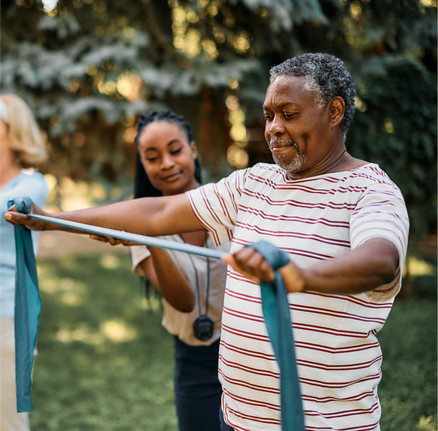While physical activity is beneficial at any stage of life, it is especially important for older adults. Intentional movement, such as walking, stretching, or dancing, can play a vital role in maintaining independence, preserving cognitive function, and supporting overall health, helping older adults lead longer, more capable lives. However, with age, the body undergoes changes that require a more thoughtful approach to exercise. Understanding these risks can help older adults make informed choices and adopt safe exercise strategies to stay active throughout their later years.
Please note: this is not medical advice. Always consult a healthcare provider before starting or modifying your exercise routine.
Understanding the Risks
As we age, natural shifts in muscle mass, bone density, joint flexibility, and balance can increase the risk of injury. These changes may lead to overuse injuries, joint pain, stress fractures, or falls. According to Temple Health, older adults are particularly prone to conditions like tendonitis, rotator cuff tears, and osteoarthritis, which can be aggravated by improper or excessive physical activity. Recognizing these risks is the first step toward building a safe and sustainable exercise routine.
Designing a Routine

Starting slowly is key to designing an ideal exercise routine. The National Institute on Aging recommends starting out with low-impact activities, such as walking, swimming, or stretching, and gradually increasing intensity over time. Each workout session should include a warm-up and cool-down to reduce stiffness and improve flexibility, thereby reducing the risk of injury. According to the CDC, adults aged 65 and older should aim for at least 150 minutes of moderate-intensity aerobic activity per week, such as 30 minutes a day, five days a week, or 75 minutes of vigorous activity, along with muscle-strengthening exercises at least two days per week. However, it is important to note that these recommendations are a general guideline, and individual needs vary.
In addition to movement, hydration is especially important for older adults, who may be more susceptible to dehydration due to age-related changes that affect the body’s ability to hold onto water or medications. Wearing supportive footwear and comfortable clothing can also help prevent falls and overheating. When weather conditions are extreme (such as hot, cold, or humid), indoor alternatives like taking a walk at the mall or partaking in home workouts can be safer options to consider.
Not every older adult has the same physical activity needs or abilities. When exercising, minding signals from the body is of utmost importance. Dizziness, shortness of breath, or pain are important signals to stop an activity and rest. Modifying exercises to suit individual comfort levels are keys to staying active without risking injury.
Choosing the Right Activities
The best exercise is one that 1) fits the individual’s lifestyle, 2) can be safely performed, and, most importantly, 3) brings joy to the participant. Some of the most popular exercises include walking, as well as swimming and water aerobics for those seeking joint-friendly options. Activities like Tai Chi and yoga help improve balance and flexibility, which can reduce the risk of falls.
Resistance training (otherwise known as strength training) is also highly beneficial for maintaining metabolic and bone health as one ages. Using resistance bands or weights can help maintain muscle mass and bone density. Even everyday tasks like gardening or carrying groceries can contribute to building one’s physical strength.
Overall, exercise has numerous benefits, and there are many different ways to engage in physical activity – there is no one right way to be active! If you have questions or concerns about starting a new exercise routine, it is wise to consult a healthcare provider. Healthcare providers such as physical therapists or physicians can provide personalized guidance, which can be especially important for those who have chronic conditions or recent injuries. A professional can help design a personalized routine that aligns with your health status and goals. With the right mindset, informed choices, and a personalized approach, older adults can embrace movement not simply as a health strategy, but as a pathway to a more fulfilling life.
Sources:
- 6 Tips for Exercising Safely as an Older Adult | LCMC Health
- Exercise and Physical Activity for Older Adults | National Institute on Aging
- Exercising Outdoors: Safety Tips for Older Adults | National Institute on Aging
- Safe and Effective Exercises for Seniors | Verywell Health
- Safe Exercise Tips for Older Adults | Temple Health
- Physical Activity Guidelines for Older Adults | Centers for Disease Control and Prevention (CDC)
